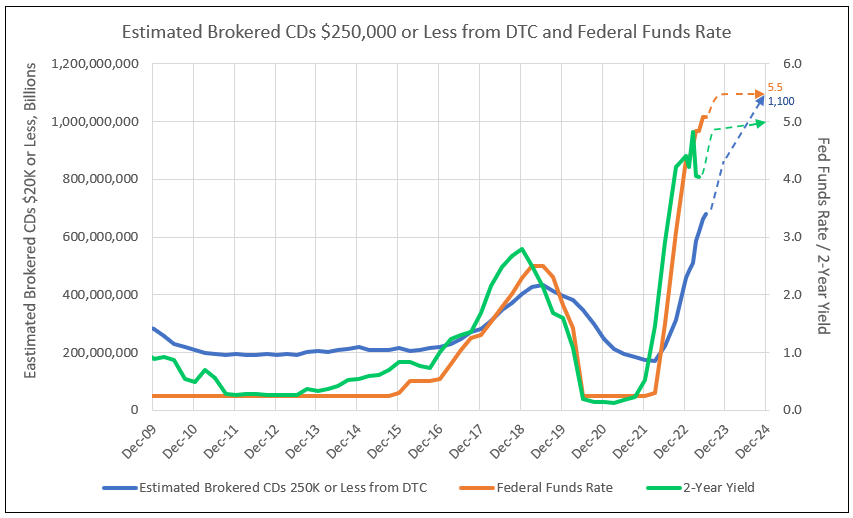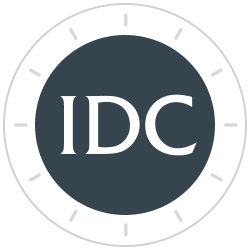Fed Funds Rate Hikes and High Two-Year Yields Forecast Significant Increases in Brokered CDs in 2024
Brokered CDs Reaching New Highs in 2024
Deposit costs at banks reflect competition from yields on the 3-month T-Bill of 5.4%, and the 2-year at 4.8%, coupled with the upward pressure of another potential 25-basis point hike in the Fed funds rate in July. Together, these yields forecast rising deposit costs for banks. One method of increasing deposits or replacing deposit runoff is to issue brokered CDs of $250,000 or less, which are fully insured by the FDIC.
IDC Financial Publishing (IDCFP) has attempted over time to estimate brokered CDs for individual banks. The unknown in the equation has historically been the level of sweep accounts in brokered deposits. As of September 30, 2021, bank reports, sweep accounts for individual banks were available on the call reports.
As of March 31, 2023, the IDCFP estimate of brokered CDs $250,000 or less as a sum of all banks was $563.7 billion compared to DTC value of $586.6 billion. The latter includes credit unions and a few foreign banks. IDCFP calculates the estimate, shown in Table II, by subtracting from the brokered deposits of $250,000 or less the fully insured sweep deposits, capped at the value of time deposits of $250,000 or less for banks with an outstanding CUSIP number for brokered CD issuance. IDCFP concludes the estimates for individual banks’ brokered CDs is reasonably accurate and available on request for your own marketing or other research needs.
DTC Brokered CDs of $250,000 or less peaked in June 2019 at $433.3 billion and declined to $395.6 billion by December 31, 2019. The significant decline in 2020 was due to Covid and the actions of the Federal Reserve Bank to increase liquidity by adding Treasuries and mortgages to its balance sheet.
The average rate of decline in DTC reported brokered CDs was $15.2 billion a month in the last three quarters of 2020, and then fell to $8.4 billion a month in the first half of 2021, then narrowed to $3.5 billion a month in 2021Q3, and then $2.8 billion a month in the fourth quarter of 2021. From year-end 2021 to the end of February 2022 balances declined $3.2 billion a month. However, since early 2022, DTC balances are rising from $169.4 billion in February 2022, to $224.3 billion in June, to $458.9 billion in December 2022, and accelerating to $586.6 billion by March 2023. As of June, the DTC balance surged to $681.3 billion.
Brokered CDs began increasing at an accelerated pace in February 2022 and continued through June 2023. IDCFP projects brokered CDs of $250,000 or less to increase $180 billion in the remainder of 2023 to a year-end balance of $861 billion. An additional increase of $239 billion is expected by year-end 2024, raising the balance to $1,100 billion (see Chart I).
Sticky Core Services Ex Housing PCE Maintains High Yields on Treasuries
The inflation outlook is more favorable toward year-end. Core Services Ex Housing PCE remains sticky at 4.27% and the Fed funds rate is expected to be raised by 25 basis points in July.
Employ America: June Core-Cast, Post-PPI1
We have found Employ America to be the best and most reliable source in the analysis and forecast of inflation. See their recent newsletter discussing the trajectory of 2023 Core PCE.
Core-Cast is Employ America’s nowcasting model to track the Fed's preferred inflation gauges before and through their release date. The heatmaps below in Table I give a comprehensive view of how inflation components and themes are performing relative to what transpires when inflation is running at 2%.1
Table I

In Table I, the outlook for zero, one or two additional hikes and the terminal rate in Fed funds is dependent on the monthly increase in Core PCE over the next six months. A monthly rate of 0.20% to 0.22% indicates the Fed is on hold. A 0.22% to 0.25% monthly increase would call for one more 25 basis point hike. A monthly gain of 0.25% or greater forecasts two hikes.
Outlook for Inflation and Brokered CDs
The Fed’s determination for a Core PCE of 2% from the current 4.15% is the “last and hardest mile.” Core PCE Ex Housing needs to run at 0.23% or less monthly rate coupled with a significant deceleration in OER and Rent inflation.
The Fed funds rate is maintained over 5%, T-Bill yields remain high and the 2-year T-Note yield continues close to 5%. All these yields are competitive to bank deposit rates, requiring issuance of brokered CDs.
Brokered CDs outstanding bottomed in 2022 and are expected to reach $861 billion by the end of this year, and $1,100 billion by year-end 2024 (see Chart I).
Chart I

Brokered CDs $250,000 or Less Estimated to Reach New High in 2023 and Grow to $1,100 Billion by 2024
IDCFP has estimates of brokered CDs $250,000 or less outstanding for each issuing bank, available on request. See below a sample list of banks.
Table II

1 - June Core-Cast Post-PPI: Will the Fed Be Dogmatic or Data-Dependent?, Employ America, July 13, 2023
To view all our products and services please visit our website www.idcfp.com.
For more information on banks with brokered CDs outstanding, and the amount of these CDs, or for a copy of this article, please contact us at 800-525-5457 or info@idcfp.com.
John E Rickmeier, CFA
President
jer@idcfp.com
Robin Rickmeier
Marketing Director
